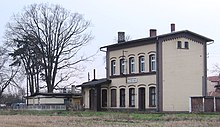Bielany Wrocławskie
Bielany Wrocławskie ( German beggars ) is a village in the rural community Kobierzyce ( Koberwitz , 1937-45 Rößlingen ) in the powiat Wrocławski ( Breslau district ) in the Lower Silesian Voivodeship in Poland .
Geographical location
The village is located in Lower Silesia in the Silesian Lowland, about 9.5 kilometers southwest of Wroclaw . Coordinates: 51 ° 2 ′ N , 16 ° 58 ′ E
history
The place is first mentioned in 1341 when King John of Bohemia granted the Wroclaw citizen Nicolaus von Zittin the Bethlern Vorwerk as a fief. The associated village was laid out as a street village. The noble village and manor beggars belonged to the Principality of Wroclaw in the 18th century . The owner of the manor was Count Felix v. Königsdorff (1791–1836). Around 1840 beggars had 49 houses, a Protestant school, a Catholic mother church with a branch in Oltaschin , an allodial manor with a manorial castle and a patrimonial court . The Protestants were parish in the parish of Domslau . A Protestant main teacher and a Catholic auxiliary teacher worked at the village school.
The Reformation found its way into beggars early. The Protestant service initially took place in the Catholic village church, which, however , had to be returned to the Catholics in early 1653 in the course of the Counter-Reformation . The first Protestant pastor was Michael Buckius from 1530–1550.
Beggar had a station on the Prussian State Railroad's Breslau – Koberwitz line since 1884 .
In 1945 beggars belonged to the district of Breslau , district of Domslau in the administrative district of Breslau in the Prussian province of Silesia of the German Empire .
Towards the end of World War II , Beggar was occupied by the Red Army in the spring of 1945 . In the summer of 1945 the region, like almost all of Silesia, was placed under Polish administration by the Soviet occupying power . The Poles introduced the place name Bielany Wrocławskie for beggars . The German population was as far as they had not already evacuated or fled from beggars expelled . Some of the newly settled residents came from the areas east of the Curzon Line that fell to the Soviet Union .
Population development until 1945
| year | Residents | Remarks |
|---|---|---|
| 1816 | 383 | |
| 1825 | 420 | 114 of them are Catholics |
| 1840 | 431 | including 97 Catholics |
| 1885 | 772 | |
| 1933 | 985 | |
| 1939 | 952 |
Protestant pastor until 1945
- Michael Buckius, 1530-1550
- Martin Weber, 1593-1605
- Johann Grun, 1605-1624
- Paul Elber, 1624-1632
- Martin Kretschmar, 1632-1633
- Christoph Steinberg, 1633–1639
- Johann Jonas Profius († 1659), since 1640, was expelled on January 10, 1653
economy
- In Bielany Wrocławskie you will find Aleja Bielany (“Alley beggars”), Poland's largest shopping park .
- In 2014, an Amazon Logistics Center was created for around 2000 employees, which also supplies Germany.
traffic
The village is on the A4 motorway and has its own motorway connection. Bielany Wrocławskie station on the Wrocław – Jedlina-Zdrój railway line is no longer served.
Personalities
- born in the place
- Friederika Henriette Louise Flemming (* 1818), German instrumentalist (piano, organ)
- connected to the place
- Felix von Königdorff (1791–1836), landowner
literature
- Johann Georg Knie : Alphabetical-statistical-topographical overview of the villages, towns, cities and other places of the royal family. Preusz. Province of Silesia . 2nd edition, Breslau 1845, p. 31 (correction of typographical errors: beggars , third line from the bottom read new ones ).
Web links
- Domslau district (Rolf Jehke, 2008)
Individual evidence
- ^ Johann Ernst Fabri : New geographical magazine . 4. Bamd, 4th piece, Halle 1787, p. 77.
- ↑ a b c Johann Georg Knie : Alphabetical-statistical-topographical overview of the villages, towns, cities and other places of the royal family. Prussia. Province of Silesia, including the Margraviate of Upper Lusatia, which now belongs entirely to the province, and the County of Glatz; together with the attached evidence of the division of the country into the various branches of civil administration . Breslau 1830, p. 35 (misprint correction: beggars , second line from the bottom read new ones ).
- ↑ a b c d e f g h Siegismund Justus Ehrhardt :: Presbyterolgue of Evangelical Silesia . Volume 1, pp. 547-548.
- ↑ Alexander August Mützell and Leopold Krug : New topographical-statistical-geographical dictionary of the Prussian state . Volume 1: AF , Halle 1821, p. 102, item 2060.
- ^ Johann Georg Knie : Alphabetical-statistical-topographical overview of the villages, spots, cities and other places of the royal family. Preusz. Province of Silesia . 2nd edition, Breslau 1845, p. 31.
- ^ A b c Michael Rademacher: German administrative history from the unification of the empire in 1871 to the reunification in 1990. sch_breslau.html. (Online material for the dissertation, Osnabrück 2006).
- ↑ www.wroclaw.pl - The foundation stone was laid under Amazon (2014-05-08)
- ↑ Carl Koßmaly : Schlesisches Tonkünstler-Lexikon, containing the biographies of all Silesian musicians, composers, cantors, organists, sound scholars, lyricists, organ builders, instrument makers, etc. etc. Volume 1, Breslau 1846, pp. 109–111.



